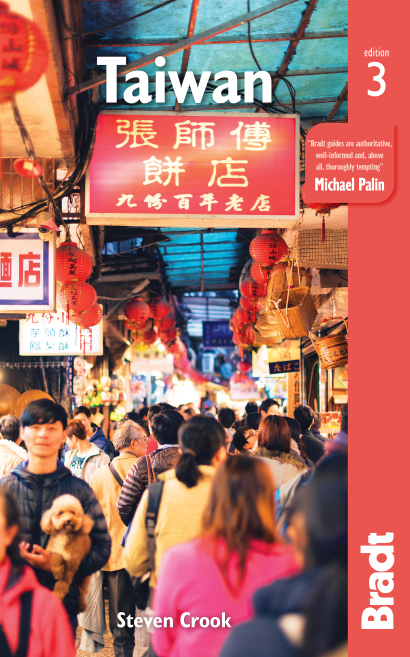A great deal of architectural energy and talent has gone into the design and construction of houses of worship. From huge decorative complexes to small colourful shrines, these are the best temples in Taiwan.
For more information about this beautiful country, see our guide to Taiwan.
As with churches and mosques, Chinese temples are laid out in accordance with certain architectural conventions. From the visitor’s perspective, the first of these concerns the three doorways at the front. The doors are always painted red – Taiwan’s temples are dominated by shades of red and gold – and usually they’re decorated with colourful full-body portraits of General Qin and General Yuchi. This duo, who lived in the Tang Dynasty, became ‘door gods’ because of their ability to repel demons. The lion statues in temple forecourts have a similar protective function; the lion pawing a ball is male, while the one with a cub is female.
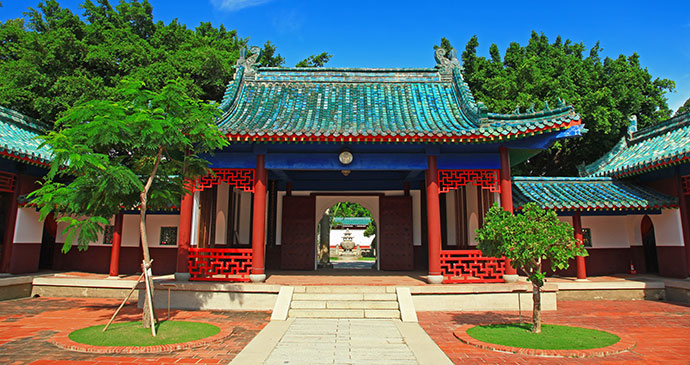
The door on the right, the ‘dragon door’, is the correct entrance to use. The one on the left, the ‘tiger door’, is the doorway by which you should leave. You shouldn’t enter by the central portal as it’s reserved for supernatural entities. The red wooden planks that lie across the bottom of each doorway are there to stop evil spirits from getting inside.
Most temples have at least three altars; some have a dozen. They’re obvious and, as you’d expect, the central altar is dedicated to the temple’s main deity. In front of each altar there’s an offertory table on which you’re likely to see joss paper, fruit, incense and candles. Ancient temples typically also contain other important relics, among them carved stone censers (modern censers are usually made of steel) and inscribed boards.
Many Buddhist houses of worship are beautiful in their simplicity. By contrast, temples where popular religion is practised are made as opulent as possible. In the eyes of those who build and decorate such shrines, less is never more. In many temples, the stone columns and wooden beams have been carved to resemble dragons and other creatures. The exteriors and roofs are often bedecked with ceramic figurines; many of the latter are mass-produced but some are superb examples of koji glazed earthenware. Identifying the legendary characters and understanding the meaning of each animal greatly enhances a temple visit; a tour guide who can explain these things is worth his or her fee.
Baoan Temple, Taipei
This feast for the eyes is Taipei’s most interesting shrine. The main shrine in the centre of the courtyard is dedicated to Baosheng Dadi (‘the life-guarding emperor’), a god of justice, sustenance and medicine who was born as Wu Dao in Fujian in AD979; a Taoist physician, it’s said he once brought a skeleton back to life.
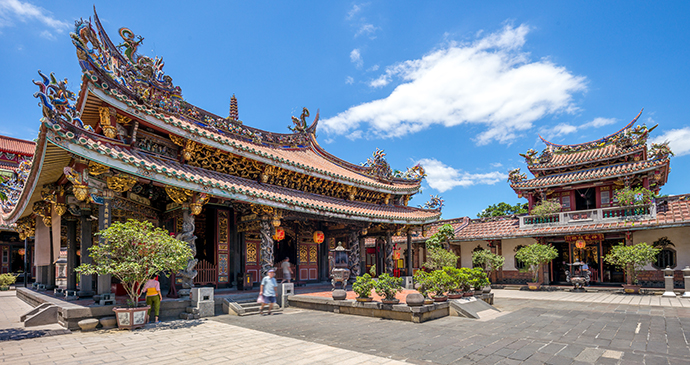
The temple’s name isn’t derived from the deity’s title. Instead it means ‘keeping Tongan folk safe’, the founders having come from Fujian’s Tongan County.
Chung Tai Chan Monastery
Designed by C Y Lee, the architect behind Taipei 101, this edifice is especially impressive if you come in the middle of the afternoon and stay until it gets dark, when the exterior is lit up. Casual visitors usually see only the Hall of the Four Heavenly Kings (dominated by 12m-high black granite statues of a quartet of guardian deities) and the adjacent Great Majestic Hall.
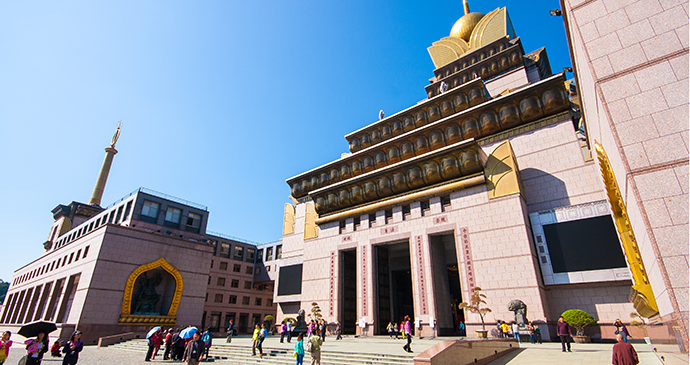
Call or email several days in advance for a guided tour (free, donations welcome) of the entire complex and an explanation of the sect’s brand of Chan (better known in the West as Zen) Buddhism.
Confucius Temple, Tainan
Possibly the most sublimely beautiful historical building in Taiwan, Tainan’s Confucius Temple is a genuine must-see. Founded by Koxinga’s son in 1665 and central to the Ming loyalists’ efforts to preserve and transmit classical Chinese values, the temple functioned as both a school and a shrine where the sage was – and each 28 September continues to be – venerated.
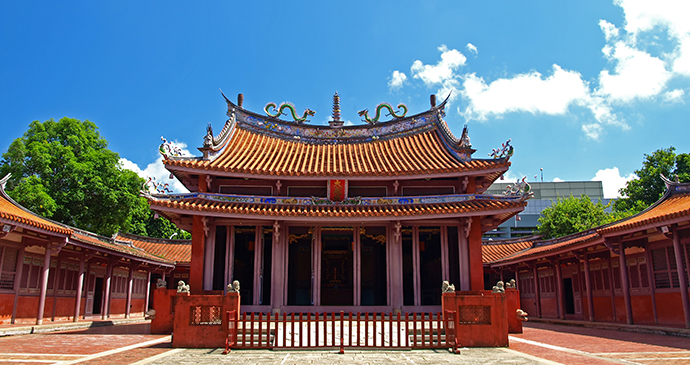
Calligraphy tablets donated by six of Taiwan’s presidents hang in the inner sanctum, and every year on the seventh day of the seventh lunar month teenagers in traditional garb ride here on horseback and offer incense to Confucius as part of the Qixi rite.
Eternal Spring Shrine, Taroko Gorge
Dramatically positioned near the base of what looks to be a highly unstable mountain slope in Taroko Gorge, this small temple (marked on many maps as Changchun Shrine) is quite a sight. Water gushes through a tunnel between the two pavilions and into the Liwu River.
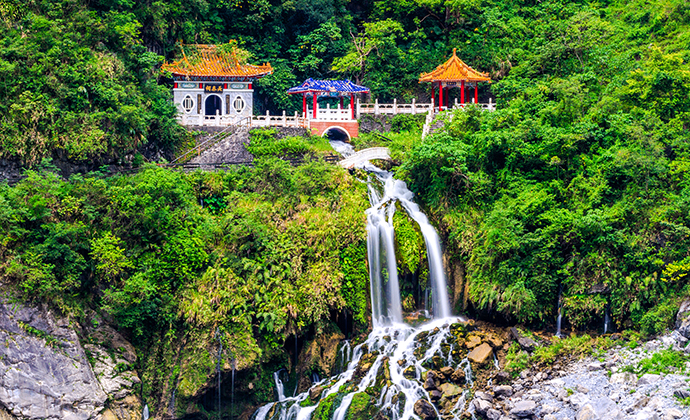
It’s possible to do an hour-long loop hike here. Walking from the Shakadang trailhead doesn’t take long, but it does involve going through a tunnel that sees quite a bit of traffic.
Longshan Temple, Lukang
Undoubtedly one of Taiwan’s most inspiring places of worship and likely the oldest Buddhist shrine on the island, Longshan Temple (founded 600m north of its current location in 1653) in Lukang is a splendid example of traditional religious architecture.
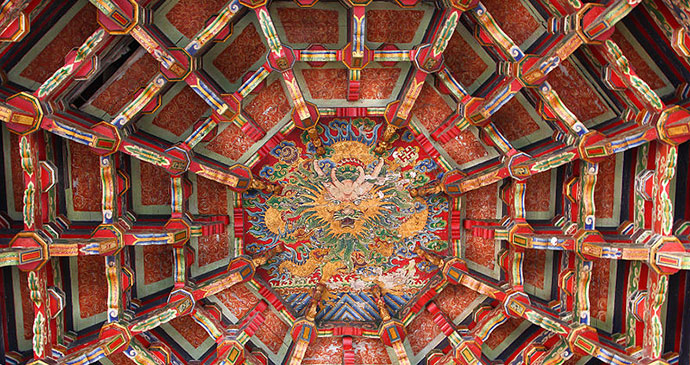
Like the finest European cathedrals, construction took generations. Despite serious earthquake damage in 1795, 1848 and 1999, the temple retains a tremendous sense of antiquity as well as considerable beauty.
Lotus Pond, Kaohsiung
Visitors adore this 1.3km-long lake and the colourful shrines and pagodas that surround it; others find it all a bit kitschy. Most of the pond’s landmarks are near its southern end, which is easily reached by train to Zuoying TRA station, connected by frequent services from Kaohsiung Main Station.
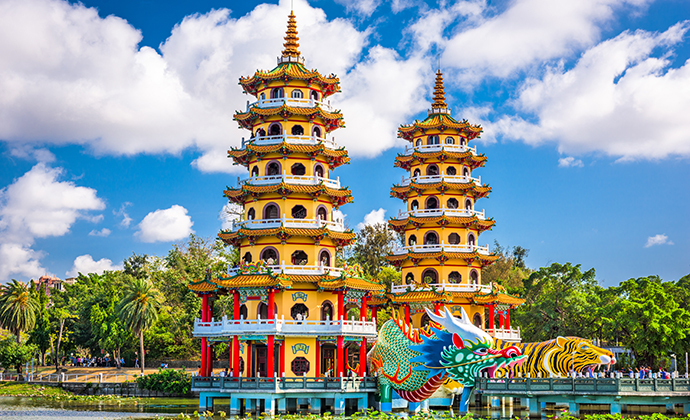
Get a leaflet from the visitor centre on the southwestern shore, then make your way to the Dragon and Tiger Pagodas and the Spring and Autumn Pavilions. At the former it’s customary to go in via the dragon’s mouth and leave by the tiger’s jaws. The most attractive folk shrine in the city proper is nearby: Qiming Temple 啟明堂 has a statue of Guan Gong in the main chamber, recognisable by his burgundy complexion.
Nankunshen Daitian Temple
Located 3km north of Beimen Visitor Centre on the inland side of Highway 17, Daitian Temple is one of the island’s oldest and liveliest places of worship and a must-see for anyone curious about Taiwanese religion.
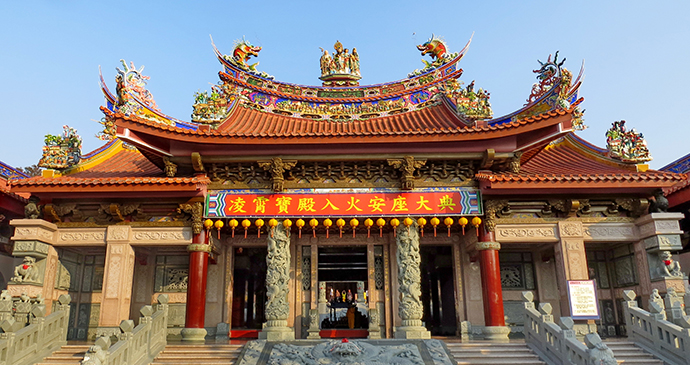
The complex has grown in recent years with the opening of Da-kun Garden Hall of Culture and History, in which you’ll find a classical Chinese garden and some Chinese-language displays about the temple, and the Lingxiaobao Hall. The latter, an annexe to the rear of the main hall, was built to house a very special depiction of the Jade Emperor, a solid-gold tablet weighing 405kg. This icon is impressive but shouldn’t distract you from dozens of fabulous beam and panel paintings.
More information
For more information, see Steven Crook’s guide to Taiwan:
